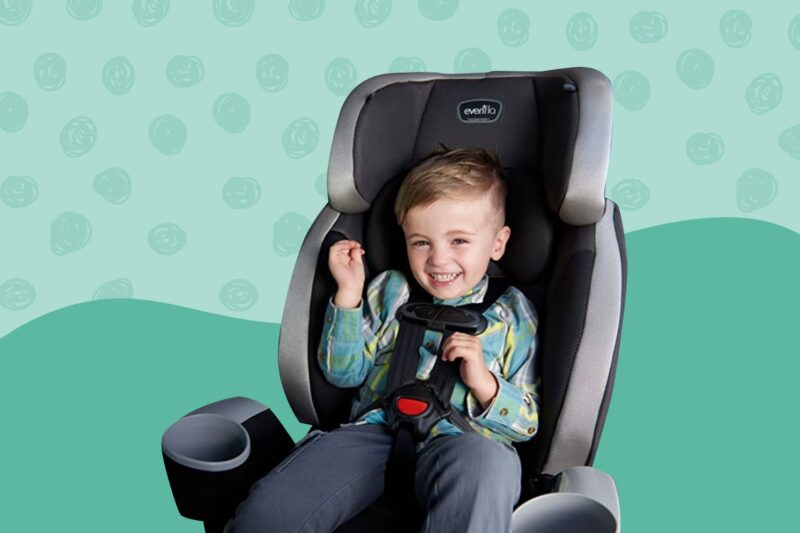Seat belts save lives, and that’s why we recommend using them when traveling in a car. But what about when your child is sitting in their seat? Should they be using a booster seat? And if so, when should you move them to one?
In this article, we’re going to answer these questions and more by providing you with the latest data and how it impacts your child’s safety. By the end of this guide, you’ll know exactly when to move your child to a booster seat and why it’s so important for their safety.
What is a Booster Seat?

A booster seat is a type of car seat that can be used to raise a child from a normal sitting position to a more upright position. In the United States, they are required for children under the age of 4.
It is designed to help children reach their full height and weight. It is usually used when they are between the ages of 3 and 6 years old. A booster seat should fit close to the child’s body and should not be too high or too low.
Children are different from adults in many aspects. They have shorter legs and shorter arms, which means they need more space to move around in their cars. This means that they need extra space for their legs when sitting on top of a regular car seat or even when sitting on top of another booster seat.
A booster seat provides this extra space for children’s legs so they can sit comfortably without touching any part of their body with the vehicle’s interior. The vehicle is designed to meet the safety standard of 49 CFR 571.208, which pertains to booster seats and convertible child restraints.
Types of Booster Seats

When you are deciding when to move your child to a booster seat, there are a few things to consider. First, the type of booster seat will determine when it is appropriate to move your child. Second, the booster seat age of your child.
There are three types of booster seats: infant, toddler, and pre-schooler. Infant seats are designed for infants who are not yet taller than 18 inches (45 cm). Toddler seats are for children who are between 18 and 36 inches (45-90 cm) tall. Pre-schooler seats are for children between 2 and 4 years old (5-10 years old).
The age of your child will help you decide when they should start using a booster seat. For example, toddlers who are 2 or 3 years old should use a toddler booster seat until they are 4 or 5 years old. Pre-schoolers who are 4 or 5 years old should use a pre-schooler booster seat until they reach the maximum height allowed for their age group.
When is a Child Ready?

There is no one answer to this question since readiness depends on the individual child and their age. However, most doctors agree that a child is ready to sit in a booster seat when they can support their head, neck, and back with their hands-free. This means that they can hold onto the chair with both hands and keep their balance while sitting.
It is important to keep in mind that readiness doesn’t mean a child is ready to use a booster seat right away. It is usually recommended that children use it for about 30% of their total car rides until they are at least 4 years old. This means that your child will probably need to use a booster seat for at least 3 out of every 5 car rides.
If you decide to move your child to a booster seat, be sure to take the following precautions:
- Get a booster seat that matches your child’s height and weight.
- Make sure your child is sitting in the seat correctly.
- Make sure the belt is properly fitted around your child’s waist and chest.
- Check the connection between the car’s seat belt and the seat.
- Adjust the angle of the chair if needed so that your child is comfortable.
- Keep an eye on your child while they are in the booster seat.
Which Booster Seats are the Best for Your Child?
When it comes to choosing the best one, there are a few things to consider. There are three types of booster seats available on the market today: high-back, front-only, and combined high-back/front-only seats.
High-back booster seats provide the most support for your child’s back and should be used for children who weigh more than 40 pounds. They should not be used for children under 3 years old or those who are shorter than 38 inches tall.
Front-only booster seats provide support for your child’s head and shoulders only and are best for children who weigh between 30 and 40 pounds. They should not be used if your child is taller than 37 inches or shorter than 33 inches.
Combined high-back/front-only seats combine the benefits of both high-back and front-only booster seats. They are a good option for children who weigh between 30 and 50 pounds and are taller than 37 inches.
How do you install a booster seat?
Installing a booster seat may seem simple, but it could be quite tricky depending on the type of car you have.
Here’s how to install one:
1) Take out your car’s manual from your glove compartment or trunk and find out how to install this type of seat
2) Make sure you purchase an appropriate booster seat for your car
3) Check that the top of the booster is at or below the bottom edge of your child’s seat
4) Place the removable headrest between your child’s knees and in front of their upper thighs
5) Attach the strap to a point on your car seat that is directly under their shoulder while they are sitting on it.
Conclusion
It’s never too early to start thinking about when your child will reach the age where they need a booster seat. By following our guidelines, you’ll be able to ensure that your child is as safe as possible and has the best chance of reaching their full potential in life. Don’t wait until it’s too late – make sure that you take action now and help ensure that your loved one is safe.


